Shelf life of fresh and live fish
If it is not possible to immediately prepare the product, it should be placed in the refrigerator. Species of fish that are least demanding of the composition of the water and the concentration of oxygen in it are allowed for live storage. For this purpose, retail outlets selling live fish are equipped with special aquariums in which proper conditions are maintained.
The taste of the future dish depends on the storage conditions of the fish.
The most important in this case are:
- water quality;
- temperature;
- oxygen content in water;
- absence of hydrogen sulfide and methane.
Water from ponds containing phytoplankton is considered unsuitable for keeping live fish.
Tap water must be dechlorinated before being used to store live fish, which is most easily done by blowing air through the water for 10-15 minutes. In addition, specialized filters and activated carbon are used to improve water quality.
Much attention is paid to water temperature. This is due to the fact that when the temperature is too high, pathogenic microflora develops in the water, and when the temperature is too low, the fish falls asleep.
The shelf life of live fish in aquariums installed in special stores is no more than 2 days.
When storing chilled fish carcasses, the main parameter is the temperature in the thickness of the meat and in the spine area, which should be within -1...-5°C. More pronounced cooling leads to freezing.
Chilled fish carcasses should be stored with ice in a 1:1 ratio. But such cooling is uneven.
It should be remembered that this may reduce the quality of the product due to injury and deformation. Products cooled by a cold liquid medium have higher quality.
In a refrigerator
The length of time fresh fish products can safely remain in the refrigerator depends on the temperature. If the refrigeration equipment is equipped with a special compartment in which the temperature is maintained at -2...0°C, fish can be stored for up to 3 days.
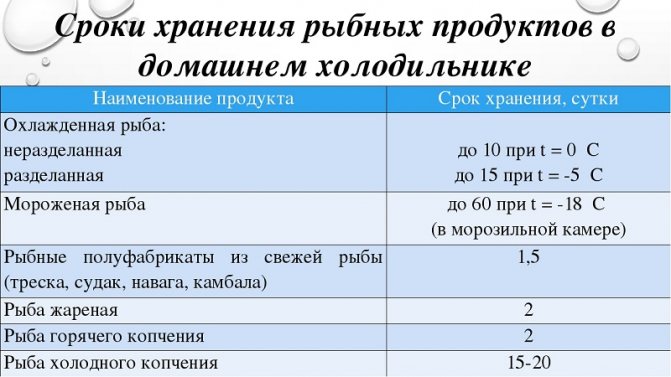
Shelf life of fish products in the home refrigerator.
At +5…+6°C the period should not exceed a day. You can extend storage a little by placing the product in a container and adding ice cubes.
In the freezer
In this case, the most reliable conditions for fish products are created. Fish is frozen if you intend to store it for more than 2 days. Place the products in the freezer in small portions, wrapping each in plastic.
Frozen fresh fish carcass can be stored for up to several months. Such storage does not affect the organoleptic properties or nutritional value.
Thaws a frozen semi-finished product for several hours. It is strongly not recommended to speed up this process with hot water or a microwave.
It should be remembered that repeated freezing of fish will dramatically change the density of the product and its organoleptic properties for the worse (thawed fish products cannot be frozen).

Shelf life of fish in the freezer.
At room temperature
It is not recommended to store fresh fish at room conditions, even for a short time. This product is perishable, and keeping it in room conditions can trigger the onset of irreversible processes.
Ready-made fish dishes can be kept at room conditions (for example, on the table) for 2 hours. After this period of time, it is recommended to put fish dishes in the refrigerator.
Vacuum packed
Vacuum packaging allows you to increase the shelf life of the product several times. During the storage period, the appearance, smell and taste of fish products are preserved. Modern technology of vacuum packaging with the addition of inert gases, used in industrial conditions, also eliminates the development of anaerobic bacteria.
The shelf life of fish products in vacuum packaging depends on the type of fish, its freshness and pre-processing.
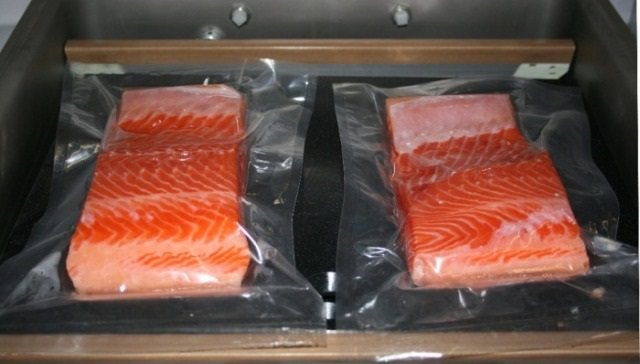
Vacuum-packed fish can be stored for several months.
Salmon packed using vacuum technology retains its properties and does not spoil in the refrigerator for up to 1 month.
In attics or basements
Long-term storage of fresh fish in attics and basements becomes safe at low temperatures - less than -10...-15°C. Under such storage conditions, the product is frozen and can be stored for up to 3-4 months without losing its consumer qualities.
In a temperature range of -1...- 5°C, fish can be stored, packed with ice, for up to several days (48-72 hours). Raw fish products should not be stored at higher temperatures.
Sun-dried fish tolerates storage in attics and basements much better. For this, a cool room protected from excess dampness is sufficient.
Preparation for storage

Rules for storing fish include a preliminary preparation stage. The algorithm is quite simple:
- Raw fish must be scaled and giblets removed.
- Wash top and inside, dry with napkins or paper towel.
- If you are going to store the product for about two days, then you need to sprinkle with salt or sprinkle with lemon juice.
- Transfer the fish to a storage container, wrap it with cling film or close it tightly with a lid.
There is no need to wash finished fish fillets before storing them in the refrigerator.
Smaller fish, such as roach or perch, can be frozen without gutting them - then they will better retain their taste and juiciness. But it is not recommended to freeze burbot at all - this fish is tasty only fresh.
There are ways to preserve fresh fish without refrigeration, invented by our ancestors at a time when no one dreamed of this technological miracle. In order for fresh fish to last 2-3 days, you need a cool and well-ventilated room. You need to do the following:
- clean from scales, gills, entrails, fins;
- wipe dry with a towel;
- rub the carcass on all sides with spices (usually salt and ground black pepper are used);
- wrap the fish in cotton cloth soaked in a solution (200 ml of vinegar and 2 teaspoons of sugar);
- Cover the inside and outside with coarse salt.
If you plan to freeze the carcass, then you need to put it in a plastic bag. It is recommended to divide a large specimen into small portions.
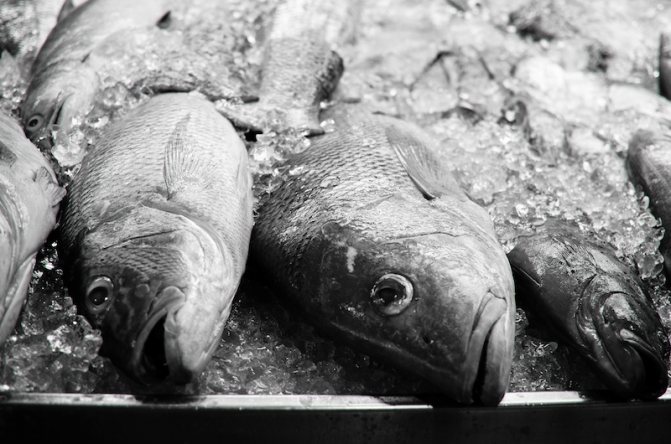
How and how long to store dried and dried fish
Only fish of high quality and without signs of spoilage, such as an unpleasant odor, are allowed to be stored dried. The storage room for dried fish should be cool.
Good fit:
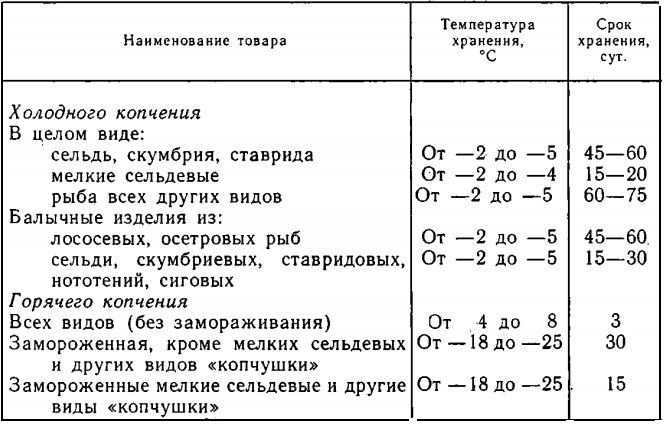
Storage temperature for smoked fish.
- pantry without windows;
- shaded balcony;
- attic.
It is recommended to wrap fish carcasses with parchment paper or tracing paper. Large fish are wrapped individually, and small fish are wrapped in small groups. This will prevent it from drying out.
The bundles are hung in places where the sun's rays do not reach. The recommended air humidity in such a room is 70-80%. At higher humidity, the fish will become moldy. Drier air in storage will cause the product to dry out.
Fish varieties with low fat content are suitable for dry storage. The best method is to store dried fish carcasses, wrapped in plastic, in the freezer. After removal from the freezer, such a semi-finished product needs to be dried.
Dried fish carcasses wrapped in paper are stored in the refrigerator for a long time. In this case, they are suitable for consumption for six months.
Large quantities of dried fish products can be stored in cardboard or wooden boxes, covered with fabric. In this form, the product can be stored for 6 months.
Freezing
The shelf life of frozen fish compared to chilled fish increases sharply, but there are also limitations:
- Temperature. The lower it is, the longer it can be stored.
- Fat content. The fatty fish varieties are stored the longest: beluga, carp, catfish, pike, mullet, cod, salmon, etc.
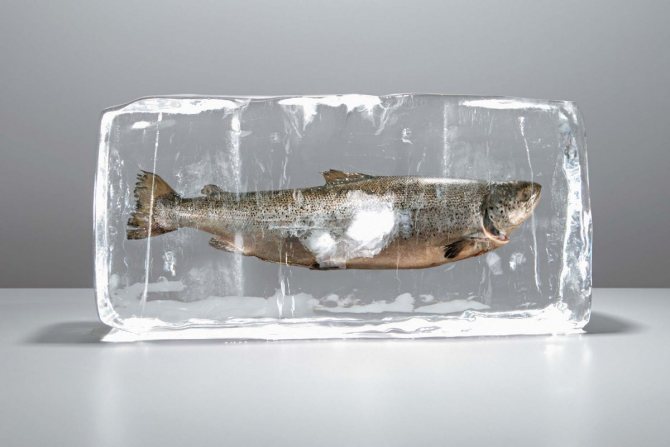
The maximum shelf life of any frozen fish is 1 year. Photo: ribxoz.ru
- How long can you store fish in the freezer?:
A detailed table for storing frozen fish is contained in the document “GOST 32366-2013 Frozen fish. Technical conditions". The full text can be found at the link.
GOST 32366-2013 Frozen fish. Specifications
Abbreviated table of shelf life of frozen fish.
| Type of fish | Shelf life | |
| -18 °C | -25 °C | |
| Salmonidae | 7-9 months | 9-11.5 months |
| Sturgeon | 7 months | 9 months |
| Whitefish | 8 months | 9 months |
| Freshwater | 6-8 months | 7-10 months |
| Flounder | 7-8 months | 9-10 months |
| Mullet | 8 months | 10 months |
| Herrings | 7-8 months | 9-10 months |
| Mackerel | 7-8 months | 8-10 months |
| cod | 7-10 months | 8-12 months |
- How to freeze fish correctly:
- Before freezing, make sure the fish is of good quality;
- Gut the carcass and rinse it in cold water.
It is not necessary to clean the fish:
- Freeze small fish whole;
- large - it is better to cut into portions;
- Dip the whole fish in the salt solution, this will create a glaze that will preserve the fish for a longer period;
- pack each fish in a plastic bag and remove the air from it;
- fillet pieces are also stored individually;
- indicate the freezing date on each bag, so you don’t miss fish that are about to spoil;
- place the fish ready for freezing in the freezer.
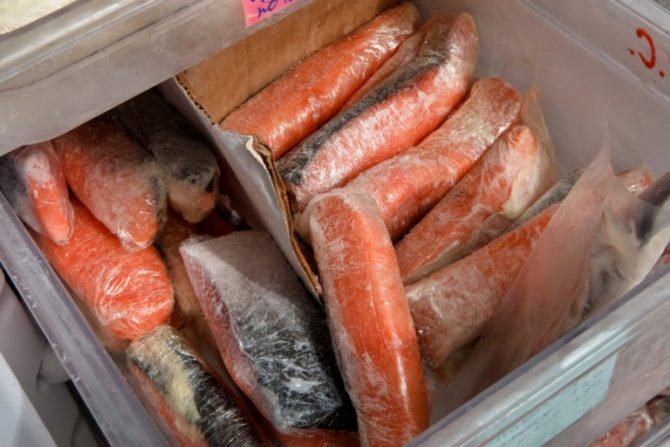
Maintaining product proximity in the freezer will preserve the taste and smell of each product. Store fish separately from meat and dairy products. Photo: stozabot.com
- How to defrost fish correctly:
- In natural conditions. Place the packaged fish in a plastic container on the bottom shelf of the refrigerator. Wait. This is a long process - about 6-9 hours. But this way you will preserve the taste and nutrients.
- In salt. Mix 25 g of coarse salt with 1.2 liters of clean cold water. Place the fish in the solution. The carcass will completely defrost in 1.5–2 hours.
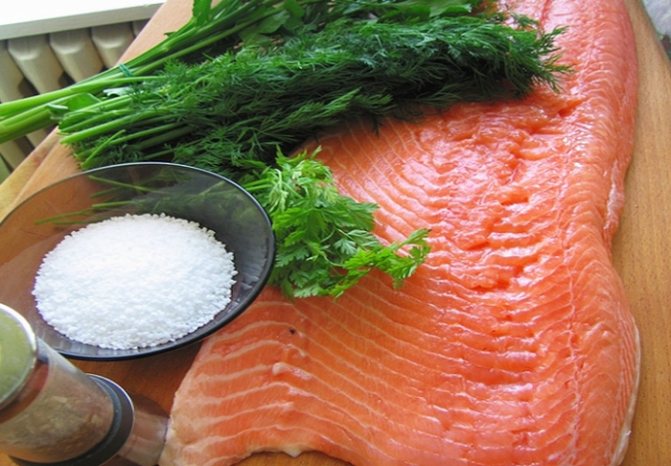
Is it possible to freeze salted red fish - yes, you can. The salted defrosting method is suitable for sea and fatty fish, as it removes all the moisture from the carcass. Photo: fishingday.org
- Running water. Place the packaged fish in a bowl and place it under running cold water. Small fish will defrost in 1.5–2 hours, large fish will take up to 3 hours.
- Microwave. The “Fish Defrosting” function will calculate the defrosting duration based on the weight of the product.
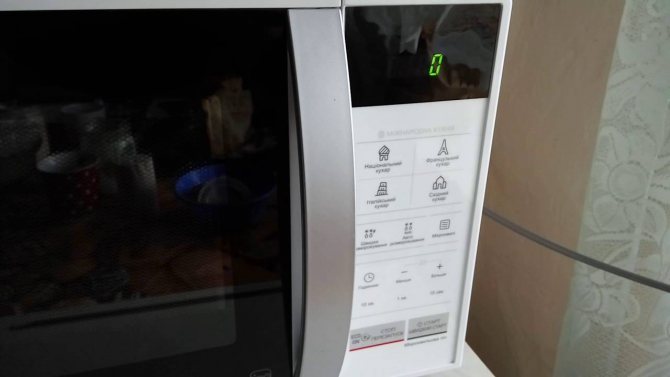
When defrosting in the microwave, you need to turn the carcass over every 3-4 minutes for uniform exposure. Photo: i.ytimg.com
- Can fish be re-frozen?
Thawed fish should be cooked immediately. A new freeze will kill the taste and all the beneficial substances. When you defrost the fish again, it will turn into mush.
How to store salted and lightly salted fish
The shelf life of salted fish is directly proportional to the amount of salt used. The presence of brine significantly increases the permissible shelf life of salted fish.
At temperatures 0…- 3 °C, shelf life depends on the type of product:
- lightly salted salmon can be stored for 2 to 3 days;
- herring - 15-20 days;
- mackerel with high fat content - from 7 to 10 days.
Lightly salted fish without vacuum packaging is usable for a maximum of 5-6 days; and marinated, medium-salted fish products can be stored for up to 2 weeks.
For the longest time - up to 3 months - you can keep herring, salmon and salmon carcasses cut into pieces in the refrigerator, provided they are filled with vegetable oil.

Factors preserving the quality of salted fish.
Storing on a refrigerator shelf
Fresh fish is best stored at a temperature of 0°C -+2°C. These conditions can be recreated in the coldest part of the refrigerator. What temperature, on which shelf, in your refrigerator model can be found in the instructions for it.
Refrigerators that do not have a special temperature-controlled zone can be equipped with containers with ice and cut up carcasses can be kept there. Ice is poured into a container, fish (fillets) are placed on it, and then ice cubes are poured on top. With this storage method, it is important to check the condition of the ice so that it does not melt. If this happens, the carcasses will end up in water and quickly spoil.
At +2°C -+5°C, the shelf life of gutted fresh fish will be 2 days.
It is not advisable to keep fish in a bag or refrigerator. This reduces shelf life to 8 - 12 hours. This bag should only be used to transport this product.
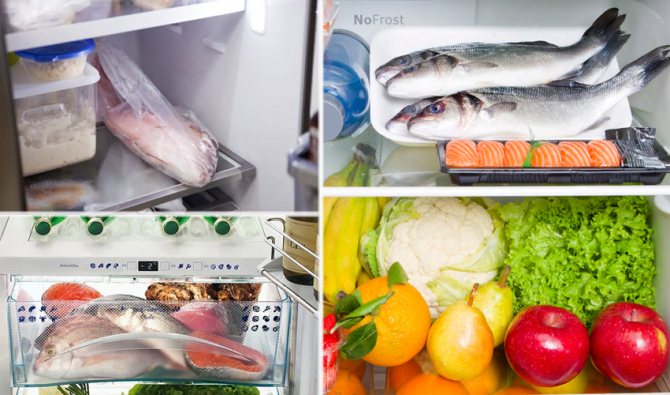
Shelf life of canned fish
Both fish carcasses, cut into pieces, and offal (for example, cod liver) are canned. The shelf life of canned fish products does not exceed 2 years.
The period during which canned fish products retain their beneficial properties and do not spoil does not depend in any way on the composition of the sauce or on the spices added during canning.
After opening, it is recommended to transfer the contents of the can into a porcelain or glass container. SanPiN prescribes storing opened canned food for no more than 24 hours.
How to store ready-made fish dishes
Ready-made fried or boiled fish dishes should not be left on the dining table for more than 2 hours at room temperature. After this time, you need to place them in the refrigerator, and then they will be usable for another 2 days.
It is recommended to store ready-to-eat Japanese dishes in special sushi chambers for no more than 48 hours.
We are talking about blanks for making rolls, carcasses cut into pieces. Already made rolls cannot be stored.
The shelf life of fish oil capsules is 2 years.
Preparation and cooling process
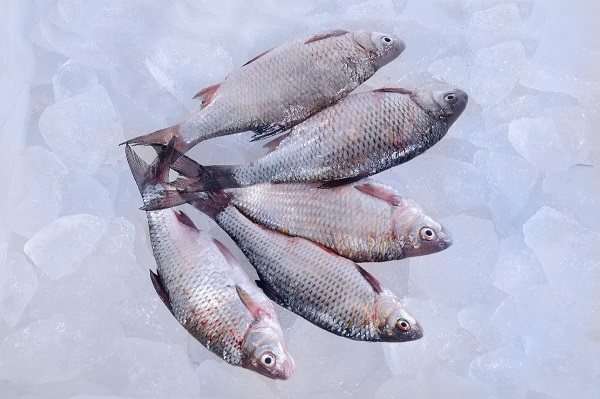
Before the cooling process begins, the fish is weighed and only then placed in a container and covered with ice. Its volume depends on the distance over which they plan to transport the seafood before it is directly displayed on the shelves. In addition to the distance of the “travel,” the time of year in which the fish is supposed to be delivered to the place of sale also plays a role. However, the size of the carcasses does not affect the way they are placed in ice - they must be covered with coolant on all sides. This approach to transportation helps to increase the shelf life of fish.
When the outside temperature does not reach +5 ̊С, the volume of ice approximately corresponds to half the total weight of the transported goods. But the warmer the weather outside, the greater the volume of ice needed to transport seafood to its destination. For example, when the air temperature is within +5...+10 ̊С, then ice needs 60% of the total weight of the cargo. When the thermometer mark exceeds +10 ̊С, then take the same amount of ice as the total mass of seafood.
Signs of fish spoilage
It is possible to determine that fish products have begun to deteriorate without conducting laboratory analysis.
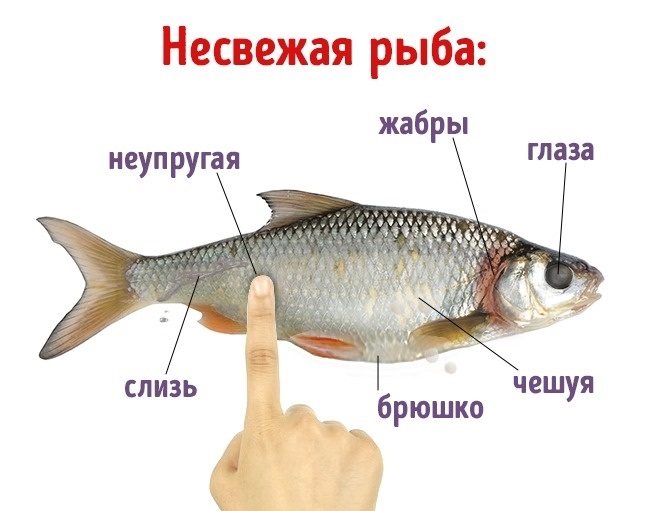
Signs of poor quality fish.
A product that has begun to lose its consumer qualities has the following signs:
- unpleasant odor;
- the presence of mucus on the gills;
- change in gill color from a natural red tint to gray, brown, greenish;
- cloudy, sunken eyes that are gray or brown;
- in naturally brightly colored fish, the bright shades disappear and become faded;
- the mucus covering the carcass becomes sticky, increases in volume, and clots appear;
- the elasticity of the meat decreases: when pressed, a dent remains that does not straighten out for a long time (in this way you can determine the freshness of both fish carcasses and fillets or steaks);
- the scales of spoiled fish fall off and come off easily;
- the meat in the ridge area takes on a reddish tint.
Product quality
Storing chilled fish only makes sense if it is of good quality. Signs of fresh fish:
- Whole fish . If the fins and abdomen are damaged, the product was defrosted several times.
- Mouth closed.
- The scales fit tightly to the carcass.
- The eyes are clean . Cloudy and flaccid corneas indicate a violation of storage conditions.
- The smell of fish . Different types of fish may smell different. But a stale product has a rotten smell that cannot be confused with anything else.
- Pink gills . The respiratory organs of fish are the first to respond to unsuitable conditions. Dark brown or gray gills are a sign of spoiled product.
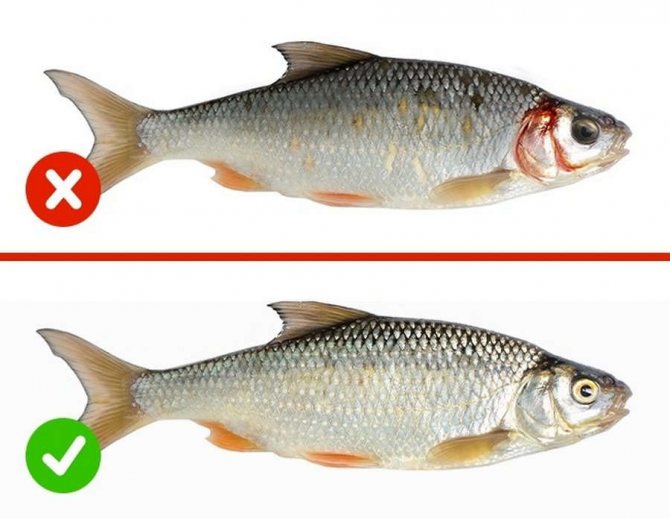
Stale fish is hazardous to health. Photo: chert-poberi.ru
How to extend shelf life
If necessary, you can extend the shelf life of fish products using the following techniques:
- freezing (staying in the freezer significantly slows down destructive processes and extends the period during which fish products retain their nutritional qualities);
- vacuum packaging;
- drying (dried fish carcasses are stored much longer than fresh, raw ones)
- salting (at home you can salt both bream caught in the river and pink salmon, trout, and halibut bought in a store); You can store salted fish in a glass jar.

Catch storage methods.











